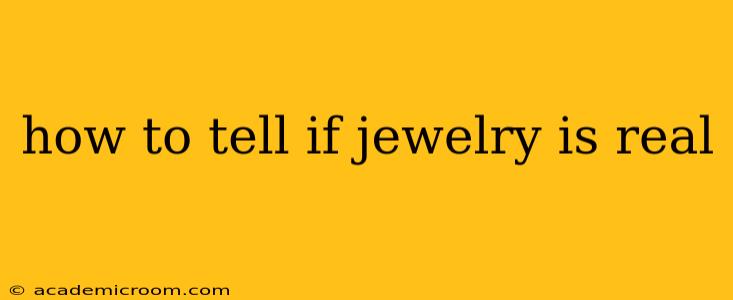Determining whether your jewelry is genuine can be tricky, especially with the prevalence of high-quality counterfeits. This guide provides several methods to help you assess the authenticity of your precious pieces, whether it's gold, silver, platinum, or gemstones. We'll cover everything from simple at-home tests to professional appraisal, ensuring you can confidently identify real jewelry.
What are the hallmarks of real jewelry?
Real jewelry often features hallmarks, small markings stamped on the piece indicating the metal type and sometimes the manufacturer or purity. These hallmarks are a crucial indicator of authenticity. For example, gold jewelry typically has a karat mark (e.g., 10K, 14K, 18K) indicating its purity. Silver pieces might be marked with a "sterling" or "925" stamp. Platinum jewelry is usually marked with "PLAT," "Pt," or a similar designation. The absence of these hallmarks doesn't automatically mean it's fake, but it warrants further investigation.
How do I check the weight of the jewelry?
Real gold and other precious metals have a significantly higher density than their cheaper counterparts. Heavier jewelry, for its size, is more likely to be genuine. While this isn't a foolproof method, it's a good first step to compare pieces of similar size and style. A noticeably lighter piece might raise a red flag.
What is the magnet test for jewelry?
H2: Does a magnet stick to gold or silver?
No, a magnet should not stick to gold or platinum. These metals are not magnetic. However, some silver alloys may exhibit slight magnetic properties due to the presence of other metals. While a magnet not sticking to your jewelry is encouraging, it's not definitive proof of authenticity.
How can I check the color and shine of my jewelry?
Real gold and silver possess a unique luster and color. Gold's color ranges from pale yellow to deep orange depending on its karat, while sterling silver has a bright, silvery-white sheen. If the color appears dull, washed-out, or unusually bright, it could indicate a counterfeit. Also, observe the shine – real precious metals have a consistent, radiant glow that is difficult to replicate.
How do I test for density using water?
H2: Can I test the density of jewelry at home?
While a precise density test requires specialized equipment, you can perform a rudimentary test at home. Weigh your piece of jewelry. Then, submerge it in a graduated cylinder filled with water and note the change in water level. The volume displaced by the jewelry can give you an estimate of its density. You can compare this to the known density of the specific metal you are testing. This method is more reliable for solid pieces and less so for hollow or intricate designs.
How can I tell if gemstones are real?
Gemstone identification requires a keen eye and sometimes professional assistance. Look for inconsistencies in color or clarity, and check for inclusions – small internal flaws that are natural in gemstones. Perfectly flawless stones are often synthetic or treated. A loupe (magnifying glass) can help you examine inclusions closely. Some gemstones possess distinct properties that can help with identification, such as hardness (tested with a scratch test, although this can be risky).
What about professional appraisal?
H2: When should I get my jewelry professionally appraised?
For valuable or important jewelry pieces, a professional appraisal is highly recommended. A qualified gemologist or jeweler can use advanced techniques to definitively identify the metals and gemstones, provide a certificate of authenticity, and assess the overall value. This is especially crucial if you plan to insure your jewelry or sell it.
Conclusion
Determining the authenticity of jewelry can involve several steps, from basic at-home tests to professional appraisal. By combining observations, simple tests, and potentially professional consultation, you can gain confidence in the genuineness of your prized possessions. Remember, always err on the side of caution, and don't hesitate to seek expert help if you have any doubts.
